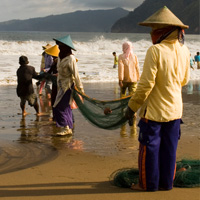
Total Awarded: $83m
Total Grants: 221
Duration: 2011 - 2016
Geographic Focus: Andes, Greater Mekong, Great Lakes of East and Central Africa
Background
Because overexploitation of species and loss of habitat are reducing the productivity and resilience of natural ecosystems upon which hundreds of millions of people depend for food, fuel, water, and livelihoods, the MacArthur Foundation’s Conservation and Sustainable Development (CSD) program launched a 10-year grant program in 2011 to protect nature in the places people depend upon it most for their well-being
The initial emphasis of which was on high biodiversity landscapes in the Mekong, Tropical Andes, Great Lakes of East/Central Africa and included what we called two global drivers of ecosystem decline – understanding and influencing China’s natural resource use and consumption patterns and the expansion of industrial scale agriculture. In 2013, the Conservation and Sustainable Development program began a complementary Coastal Marine initiative. In 2015, one year earlier than planned, Conservation and Sustainable Development program initiated an evaluation.
What We Evaluated
With a goal of sustaining the ecosystem services that underpin human well-being in high biodiversity land and seascapes by reducing current rates of biodiversity and natural habitat loss, our strategy emphasized making the value of healthy ecosystems more visible to economies and societies and expanding incentives to conserve them. We focused on convincing individuals, communities, companies, and governments that it is in their best interest to conserve nature because of the benefits it provides them and showing how it can be done as a path to broader and more effective implementation of direct conservation action in the highest priority sites, landscapes and seascapes.
The purpose of this evaluation was to understand: 1) the efficacy of the program’s approach and its outcomes and impact to date; 2) the relevance of the program and its priorities with respect to the problem of global biodiversity loss and the potential for philanthropy to catalyze effective solutions; and 3) the contribution of the program to climate change mitigation and ways to increase its impact.
What We Learned
The evaluation concluded that the Foundation’s investment in biodiversity conservation since 2011 has produced numerous achievements, with new and anticipated grants promising further progress. More specifically, it concluded that most of the regional portfolios and global grants were convincing and aligned with the strategy. In a few cases, individual grantee achievements were characterized as remarkable. This work included:
- Strengthening the land management capacities of indigenous groups throughout the Andes.
- Mounting some effective challenges to the relentless advance of hydropower dam construction on the Mekong.
- Building the field of ‘sustainable commodities production’ with its considerable potential to both conserve forests and reduce carbon emissions.
- Key advances in collaborative shark and ray conservation, notably in Indonesia.
- Marine protected area conservation in Cuba and Madagascar, building on earlier CSD work.
In addition, the evaluation produced the following lessons:
- Sustained engagement and flexibility are key to impact. The program’s long-term commitment to the priority land and seascapes, including strong, enduring relationships with grantees that emphasize shared long-term program goals over projects have facilitated results.
- Striking the right balance between traditional and innovative approaches to conservation is a process that requires experimentation and course corrections.
- Donor partnerships and coordinated grantmaking around common objectives can enhance collective impact. Working in a donor collaborative helped us to establish a common, and sometimes more sophisticated, understanding of the threats and opportunities in a region.
- A universal theory of change is most useful for developing and communicating a grantmaking strategy; it is less helpful to guide grantmaking in a given problem and geographic context. The product of a global theory of change may be too broad, and too simplistic, to usefully guide regional grantmaking, where opportunities, threats, and players shift quickly.
- When investing in science, good planning will determine the conservation payoff. Scientific analysis and communication are valuable, but insufficient means to ensure effective environmental conservation.
- Defining an appropriate grantmaking niche is critical to success.
More Information
Download the complete evaluation ›
View program team reflections on the evaluation ›
Evaluation of grantmaking in the Lower Mekong ›
Independent Evaluation of Conservation and Sustainable Development Grants (2000-2009) ›
View MacArthur's evaluation philosophy ›



